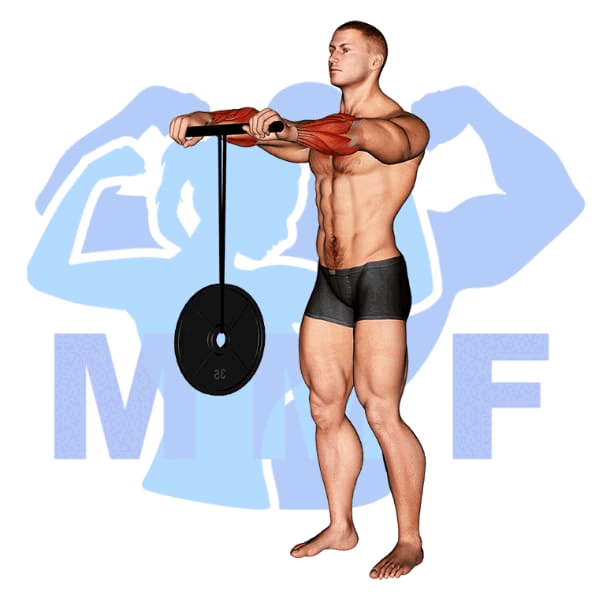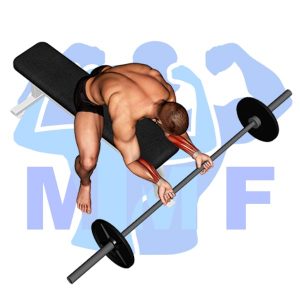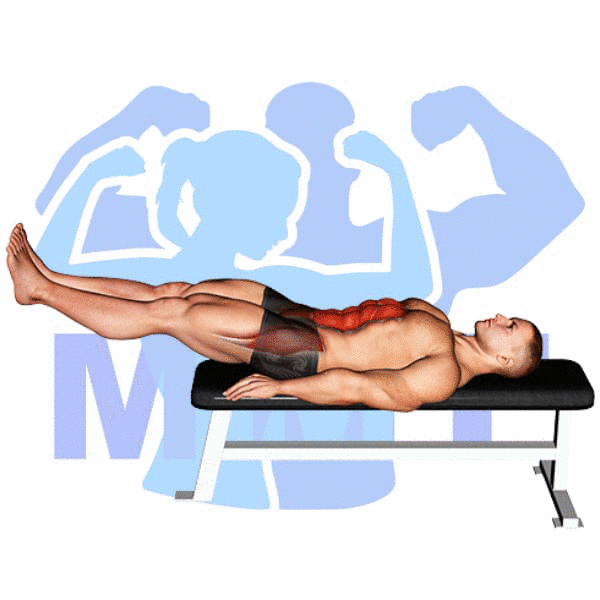Wrist Roller Forearms is an impressive isolation exercise. Are you looking for an exercise that will give you the powerful, toned forearms of your dreams? Look no further than the wrist roller forearms exercise. This exercise is perfect for anyone looking to get fit, and it’s simple to learn. Not only will it give you the strong forearms you’re looking for, but it’ll also work on your grip strength, making you look as strong as you feel. Keep reading to learn how to do this exercise properly, what the benefits are, which muscles it targets, helpful tips and common mistakes. Let’s get rolling.
- Wrist Roller Forearms Summary
- Wrist Roller Forearms Instructions
- Video Tutorial
- Wrist Roller Forearms Muscles
- Benefits of Wrist Roller Forearms
- Tips for Performing Wrist Roller Forearms
- Benefits and Tips Video
- Frequent Mistakes To Avoid
- Variations and Complementary Exercises
- Opposing Complementary Exercises
- Recap
Wrist Roller Forearms Summary
- Primary Muscles: Wrist Extensors
- Secondary Muscles: None
- Equipment: Wrist Roller
- Mechanics Type: Isolated
- Force: Pull
- Utility: Auxiliary

Wrist Roller Forearms Instructions
- Stand with feet hip-width apart.
- Grasp a weight, such as a dumbbell or medicine ball, with both hands.
- Hold the weight in front of your body at shoulder height.
- Keep your elbows slightly bent and your wrists straight.
- Rotate your wrists in a circular motion, rolling the weight up and down.
- Do 10 to 15 rotations in each direction for 1 set.
- Rest for 30 seconds between sets.
Video Tutorial
Wrist Roller Forearms Muscles
Target (Agonist)
- Wrist Extensors
Synergists
- None
Dynamic Stabilizers
- None
Stabilizers
- Brachioradialis
- Biceps Brachii
- Brachialis
- Deltoid – Anterior
- Trapezius – Upper
- Trapezius – Middle
- Levator Scapulae
Antagonist Stabilizers
- None

Benefits of Wrist Roller Forearms
The wrist roller forearm exercise is an effective way to build strength in the wrist extensors. This exercise works the wrists and forearms in a natural motion, and it helps to strengthen the muscles of the wrist extensors. The wrist roller also helps to improve coordination, balance, and grip strength, making it a great addition to any strength training or fitness routine. Additionally, performing this exercise regularly can help to improve overall arm strength, as well as flexibility in the wrists and forearms.
Tips for Performing Wrist Roller Forearms
If you want to get fit, then the wrist roller forearm exercise is a great way to do it. Not only does it help you build muscle strength in your arms and wrists, but it also helps improve your grip strength and overall fitness. To get the most out of this exercise, here are some useful tips that can help you maximize your results.
- Ensure the Wrist Roller Forearm is securely fastened to a solid surface: To ensure proper form and maximize the effectiveness of the exercise, it is important to make sure the wrist roller is securely fastened to a solid surface. This will help minimize any wobbling or instability which can cause incorrect form and lead to injury.
- Use proper form: When performing the Wrist Roller Forearm exercise, it is important to keep your arms straight and move them in a slow and controlled manner. Do not swing the roller up and down quickly as this can cause strain on your wrists and forearms.
- Monitor your progress: It is important to keep track of your progress when performing the Wrist Roller Forearm exercise. You can do this by counting your repetitions or keeping a log of how much weight you are using. Doing this will help you identify any areas that need improvement and push yourself to reach your goals.
Benefits and Tips Video
Frequent Mistakes To Avoid
When it comes to the wrist roller forearms exercise, it is important to avoid certain mistakes so that you can perform the exercise safely and effectively. To ensure that you get the most out of your workout, there are some common mistakes that you should be aware of and strive to avoid. Below is a list of the most common mistakes to watch out for when performing this exercise.
- Not using proper form: It is important to keep the elbows in close to the body while performing the exercise and keep the arms stationary in order to properly engage the forearms.
- Not going slow enough: Going too fast can lead to momentum taking over the exercise instead of engaging the forearms. It is important to go at a slow and controlled pace so the forearms are being worked.
- Using too much weight: Using too much weight can put strain on the wrists and increase risk of injury. It is important to start off light and gradually increase weight as form and technique improve.
Variations and Complementary Exercises
When it comes to developing and strengthening the forearms, there are several variations, complementary, and alternative exercises that can be used in place of or in addition to the wrist roller forearms exercise. These exercises can help to create a more balanced arm workout and improve overall strength. Below are a few examples that can be used.
Standing Dumbbell Zottman Preacher Curl

The Standing Dumbbell Zottman Preacher Curl is a great alternative or complementary exercise to the Wrist Roller Forearms. This exercise helps to build strength in the arms and forearms, while also engaging the biceps. The curl is performed by standing with two dumbbells in each hand and then curling the weight up towards the chest while keeping the palms facing away from the body. At the top of the curl, the wrists should be rotated so that the palms face each other and then slowly lower the weights back down. This exercise is great for building strength in both the arms and forearms, while also working on flexibility in the wrists.
Seated Dumbbell Revers Grip Concentration Curl

The Seated Dumbbell Reverse Grip Concentration Curl is a great alternative or complementary exercise for the Wrist Roller Forearms. This exercise focuses on the biceps, but also works the forearms, providing an effective workout for both muscle groups. It is important to keep the elbows still and close to the body while performing this exercise, as it will help to target the muscles more effectively. The reverse grip allows for increased range of motion, resulting in a greater challenge for the muscles. It also allows for a greater contraction of the muscles, which can help to increase strength and size of the forearms.
EZ Bar Reverse Grip Preacher Curl

The EZ Bar Reverse Grip Preacher Curl is an excellent complementary or alternative exercise for the Wrist Roller Forearms. This exercise focuses on the brachioradialis and biceps muscles, which are key for forearm strength and stability. By using a reverse grip on the EZ bar and performing the exercise on a preacher curl bench, you are able to isolate the muscles and get an effective workout. This exercise is especially beneficial for those who struggle with wrist roller forearm exercises due to wrist injuries or poor form. It is also a great way to increase forearm size, as well as muscular strength and endurance.
Check Out These Top Weighted Exercises
EZ Bar Reverse Grip Curl

The EZ Bar Reverse Grip Curl is a great alternative or complementary exercise for the Wrist Roller Forearms. This exercise focuses on isolating the biceps and forearms to increase strength and size. It also works the brachialis, a muscle that is often overlooked but can help improve arm size and shape. The reverse grip on the EZ bar allows for an increased range of motion and greater activation of the biceps, making this an excellent exercise for improving arm size and shape. It can be performed with moderate to heavy weights and can be used as an alternative or complementary exercise to the Wrist Roller Forearms.
Dumbbell Zottman Preacher Curl

The Dumbbell Zottman Preacher Curl is a great complementary or alternative exercise for the Wrist Roller Forearms. This exercise requires you to hold a dumbbell in each hand and curl it up towards your shoulder while keeping your palms facing down. During the curl, you rotate your wrists so that when you lower the dumbbells, your palms face up. The Zottman Preacher Curl works both the biceps and the forearms, providing an effective workout for both muscles. This exercise also helps to improve grip strength and hand coordination, making it an ideal choice for athletes looking to increase their performance in sports.
Dumbbell Zottman Curl

The Dumbbell Zottman Curl is a great exercise to work the forearms and develop grip strength. It is a variation of the traditional bicep curl and is performed by curling a pair of dumbbells up to shoulder level, then turning the palms down and lowering the weights until the arms are extended. It is a complementary exercise to the Wrist Roller Forearms, as it focuses on the same muscle groups and emphasizes different aspects of forearm strength. The Dumbbell Zottman Curl helps to build muscular endurance in the forearms, while the Wrist Roller Forearms helps to increase grip strength. Together, these two exercises will give you a full forearm workout.
Opposing Complementary Exercises
In addition to Wrist Roller Forearms, there are several other exercises that can be done to further strengthen the forearms. To ensure balanced development, it is important to also include exercises that target the opposing muscle groups. Below are a few exercises that you can use to work out the opposite muscles of the Wrist Roller Forearms.
Barbell Behind Finger Curl

Barbell Behind Finger Curl is a great exercise to complement the Wrist Roller Forearms. This exercise targets the opposing muscle group of the forearms, which is the wrist extensors. You should hold a barbell behind your fingers with your arms extended and then curl the weight up and back down. This exercise helps to strengthen the wrist extensors, which can help to improve overall wrist strength and stability. It also helps to increase grip strength, which is important for activities that require gripping, such as rock climbing. This exercise can be done with light weights for high repetitions to build endurance or with heavy weights for low repetitions to build strength.
Barbell Wrist Curl

The Barbell Wrist Curl is a great exercise to complement the Wrist Roller Forearms. This exercise works the biceps, which are the opposing muscle group to the forearms used in the Wrist Roller Forearms. The Barbell Wrist Curl helps build the strength of the upper arm and the wrists, and helps you to control the weight during the exercise. When done correctly, it can help to improve your grip strength and overall muscular balance in your arms.
Dumbbell Behind Back Finger Curl

The Dumbbell Behind Back Finger Curl is a great exercise for strengthening the muscles of the forearms and wrists. It works the opposite muscles to the Wrist Roller Forearms, which focuses on the flexor muscles of the forearms. By incorporating both exercises into your workout routine, you can ensure that all of the muscles in your forearms and wrists are getting worked. The Dumbbell Behind Back Finger Curl is a great complement to the Wrist Roller Forearms, as it targets the extensor muscles of the forearms, helping to create balanced strength and stability in the area.
Recap
Wrist roller forearms can be a great addition to any fitness routine. Not only does it increase your grip strength and strengthen your forearms, it can also help you become more fit overall. With these simple tips, you’ll be able to get the most out of your workouts. Just remember not to overdo it and listen to your body. As always, make sure to check with a medical professional before starting any new exercise routine. Now that you’ve learned all about wrist roller forearms, why not take your fitness journey to the next level and check out some of our other articles? Let’s get moving!
References: Wikipedia | ExRx.net | PubMed.gov




